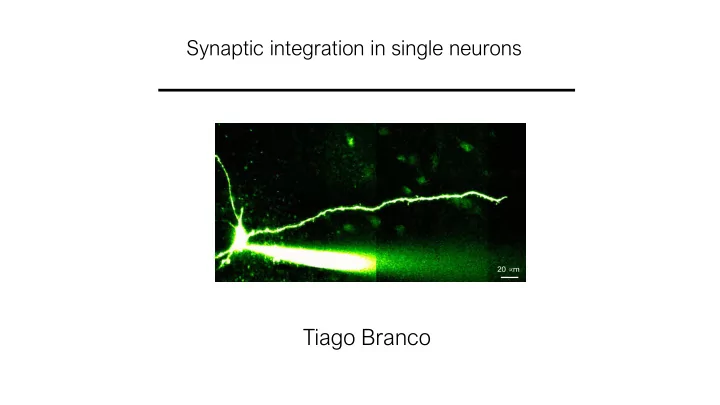

Synaptic integration in single neurons 20 µ m Tiago Branco
Model Neuron Molecules dV i – (V i – V rest ) + j w ij g j (t) = dt
Why do we care?
Input-output function of single neurons C dV g syn (V syn – V rest ) = dt
Synaptic conductance and currents Single synapses are weak and brief 2 ms 1 nS 65 pA I ion = G ion × m - E ion ) ( V
Equivalent electrical circuit of the membrane out t m = R N C N R N C N V rest in voltage equals current times resistance Ohm ’ s law: V = IR (only at steady state) At rest, the cell membrane is electrically equivalent to a parallel RC circuit
Membrane potential in response to step current Growing phase Decaying phase V I time 20 ms Growing phase: t m = R m C m Decaying phase: Membrane potential responds to a step current with exponential rise and decay, governed by the membrane time constant, t m
Membrane potential in response to synaptic current EPSP decay through resting (leak) t m K channels (determined by ) peak of EPSP EPSP still rising steepest slope of EPSP V I time A PSP is slower than a PSC, and its decay is governed by the membrane time t m constant, .
Membrane potential in response to synaptic current 0.5 mV V I 1 nS 2 ms 65 pA
Basic problem V threshold 20 mV V rest Most neurons need to integrate synaptic input to generate action potential output Integration allows for Computation
How is synaptic input integrated ? Timing
Membrane time constant sets summation time window Integration Coincidence detection M. Scanziani
Basic Input-Output function Sublinear Linear excitatory synapse 2 excitatory synapse 1 EPSP 1+2 EPSP 1 EPSP 2 by subtraction
Voltage-gated conductances change IO function C dV g syn (V syn – V rest ) + g Nav (V Nav – V rest ) + g Cav (V Cav – V rest ) + g Kv (V kv – V rest ) = dt
Dendritic trees add a spatial dimension to integration Location Timing Timing
Current flow in neuron with dendrites Wilfrid Rall
Voltage attenuation in cables Space constant R m . d λ = R i . 4 Voltage attenuation V = V 0 e -x/ λ Electrotonic distance
Compartmental modeling of neurons The NEURON simulation environment
EPSP attenuation by dendrites Wilfrid Rall, 1964
Effects of location, R m and R i on EPSP attenuation
Input-Output function in dendrites Linear Sublinear
Computation of input direction
Voltage-gated conductances change IO function C dV g syn (V syn – V rest ) = + g Nav (V Nav – V rest ) + g Cav (V Cav – V rest ) + g Kv (V kv – V rest ) dt
Voltage-gated conductances change IO function I h channels
Dendritic Spikes Ca 2+ spikes Na + spikes from Llinas & Sugimori 1980
Dendritic patch-clamp recording Stuart et al., Pflüger’s Archiv, 1993 Spruston et al., 1995
Dendritic Spikes Neocortical layer 5 pyramidal neurons Stuart and Sakmann, Nature 1994 Stuart et al, J. Physiol. 1997
Backpropagating action potentials Dopamine neurons: high Na channel density and little branching. Layer 5 pyramidal neurons: moderate Na channel density and moderate branching; more branching in the tuft. Purkinje neurons: low Na channel density (none in dendrites) and extensive branching. Distance from soma (µm) Vetter et al, J. Neurophysiology, 2001
Backpropagating action potentials
Active properties in dendrites
Input-output function varies with dendritic location
Dendritic computation of input sequences 1 4 5 5 2 1 3 7 3 5 1 6 4 2 6 8 5 3 4 3 6 8 8 2 7 6 2 1 8 7 7 4
Near-perfect integration
How do we move forward?
Critical step missing Measure the actual input-output function of a single neuron in vivo while performing a known computation
Measuring input-output subsets in the sensory cortex
Roadmap Measure input activity in all ll synapses Measure sub and supra-threshold output Formalise the transformation Identify key ion channels ( molecular biology ) Make models and generate predictions about integration Test predictions and generalise models Incorporate in network models and tell PEL how the brain works
Recommend
More recommend